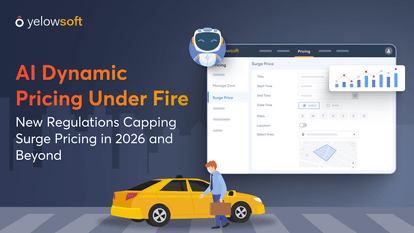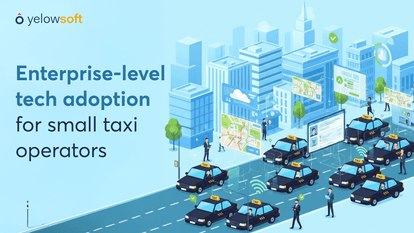The ride-hailing industry is entering a new era. What once relied on routine scheduling, phone-based bookings, and fixed dispatch models now demands real-time intelligence, adaptability, and predictive precision.
Operators who continue using static systems are already feeling the pressure. Delays are more frequent, cancellations are rising, and both drivers and passengers face growing frustration.
Although many businesses have moved to digital dispatch tools, the real shift ahead involves much more than simple automation.
It is about adopting AI powered operational intelligence that can learn from every booking, respond to live demand signals, and optimize decisions automatically.
These intelligent platforms are quickly becoming the backbone of competitive mobility operations.
So, instead of asking whether to upgrade, operators should be asking how fast they can transition to smarter systems. The future is already unfolding, and those who invest in AI based mobility software today will be better positioned to lead.
In this blog, we will break down the structural challenges mobility operators face today and explore how intelligent systems are shaping the future of fleet management and dispatch.
The Structural Challenges Operators Can’t Ignore
Ride-hailing operators are facing deeper issues than poor performance. These are signs of outdated systems trying to survive in a real-time, high-pressure environment.
Across cities large and small, ride-hailing operators are experiencing a common set of issues. Customers wait longer. Drivers cancel more frequently. Dispatchers burn out trying to make the system work. These are not surface-level problems. They point to something much more serious—a structural gap between how traditional operations were built and what today’s market demands.
If your fleet still runs on a system where every decision depends on manual action or fixed rules, you are likely dealing with:
- Long wait times because of reactive dispatch
- Cancellations due to mismatched driver assignments
- Idle vehicles sitting in low-demand areas
- Revenue losses from poor ride completion rates
- Dispatchers stretched thin with increasing complexity
These problems are not caused by a lack of effort or staff dedication. They exist because older systems were never designed to handle real-time data, shifting demand, or dynamic city conditions.
This is where an AI enabled mobility solution becomes not just helpful but essential. By understanding patterns, forecasting demand, and providing intelligent recommendations, these systems solve what spreadsheets and outdated dashboards simply cannot.
So, if the day-to-day feels harder than it should, it is likely because your operation is built for a world that no longer exists.
Let us now explore why demand is no longer linear—and why operations must evolve to reflect that reality.
Demand Is No Longer Linear — Operations Shouldn’t Be Either
Rider demand has become unpredictable. So your operations must be flexible enough to respond to it in real time—not after it’s too late.
Let’s be honest. Ride-hailing demand is anything but steady. Some mornings start slow and then explode near airports.
School dismissals create sudden spikes. A little rain can triple bookings in minutes. You already know this. The challenge is not recognizing the change—it is responding to it effectively.
Static fleet planning assumes that demand looks the same every hour of the day. But you and I both know that is never the case.
When your drivers are deployed based on yesterday’s trends, your passengers get delayed, your drivers get frustrated, and your revenue takes a hit.
That is why the smartest operators are shifting toward Intelligent Demand Response—a model that uses real-time data to adjust fleet availability to where and when rides are actually needed.
And here is where AI based mobility software makes all the difference. It does not wait for things to go wrong before reacting. It helps you:
- Place drivers in high-demand zones before the surge even begins
- Reduce idle time and keep more drivers engaged with back-to-back rides
- Identify high-value rides before they come in, boosting revenue
- Minimize dispatcher guesswork through live insights and predictive tools
This is not about replacing your team. It is about equipping them with tools that think ahead, act fast, and remove the guesswork.
Now that we understand how demand behaves, let’s look at what powers these intelligent responses behind the scenes.
Building a Continuous Intelligence Loop
Smart mobility operations do not run on autopilot—they improve every hour, every ride, every decision. And it all starts with data.
If you are serious about scaling your fleet and improving margins, you cannot rely on static reports and delayed updates anymore. What you need is a system that gets smarter every time a ride is booked, completed, canceled, or rerouted.
This is what the best operators are doing. They are building what I call a Continuous Intelligence Loop—a live system that combines data, AI, and analytics into one powerful feedback engine. Let me break it down for you.
Fleet Operations
Start with core metrics: vehicle shift hours, revenue per car, energy usage, and driver efficiency. All of this gets captured in real time.
Data Capture
You are not just getting numbers from one place. Data comes from driver behavior, customer actions, third-party brokers, even weather feeds and booking trends.
Analytics and Modeling
This is where it gets powerful. Predictive demand heatmaps, zone-based efficiency scores, and optimized pricing models are created using historical and real-time input.
Real-Time Action
Here’s where the loop closes. Your system can reposition drivers before a spike, send ride offers faster, offer incentives instantly, and even adjust pricing—all without waiting for manual approval.
And to make this all work, you need more than a dashboard. You need an AI based taxi software that ties it all together. A system that does not just record what happened, but actually improves how your fleet performs going forward.
Because if your system only tells you what went wrong yesterday, you’re already too late today.
Now let’s talk about what the most forward-thinking operators are doing next—and how they are preparing to lead over the next three years.
What Strategic Operators Will Focus on in the Next 3 Years
The ride-hailing businesses that succeed tomorrow are already making smarter choices today. The difference lies in how they think—and what they prioritize.
If you have been running your fleet for a while, you already know that growth is not just about more bookings. It is about better decisions, faster actions, and tools that grow with your business instead of slowing it down.
So, what are the smartest operators doing to get ahead?
They are not just reacting to daily problems. They are planning for scale, designing for flexibility, and investing in systems that actually support growth.
Here is where their focus is shifting:
- Predictive fleet deployment
They no longer wait for ride requests to assign drivers. They use smart models to predict where demand will rise—and get drivers there in advance. - Omni-channel booking integration
Whether it is an app, a broker, WhatsApp, or a website, everything flows into one clean system so nothing gets lost or delayed. - Live operational dashboards
They have moved beyond weekly reports. Real-time metrics help them adjust pricing, assign resources, and respond instantly when something changes. - Profit per hour instead of just ride volume
Every trip is tracked not just for how far it goes, but for how much value it adds to the bottom line. - Modular platforms that grow with the business
From airport transfers to subscription rides, they want a solution that adapts—not something that locks them in.
And here’s the truth: none of this works unless you are using the right technology. That is why so many operators are switching to smart taxi software that brings all these capabilities into one place.
Because in the next three years, the gap between operators who innovate and those who resist will only grow wider.
Let’s wrap up with a look at why this shift to AI-powered systems is no longer optional—and why now is the right time to act.
Conclusion
The mobility industry is evolving quickly, and staying ahead means going beyond basic tools.
Operators who want sustainable growth need systems that can learn, adapt, and improve continuously.
With an AI based mobility software, you gain visibility, faster decision making, and full control across your operations.
Choosing an AI enabled mobility solution is no longer a choice but a necessary step toward long term success.
Whether you manage a small fleet or a large network, investing in intelligent technology today helps you build a smarter, more profitable, and future ready mobility business.
Operate smarter. Scale leaner. Compete stronger with AI-Powered Software.




